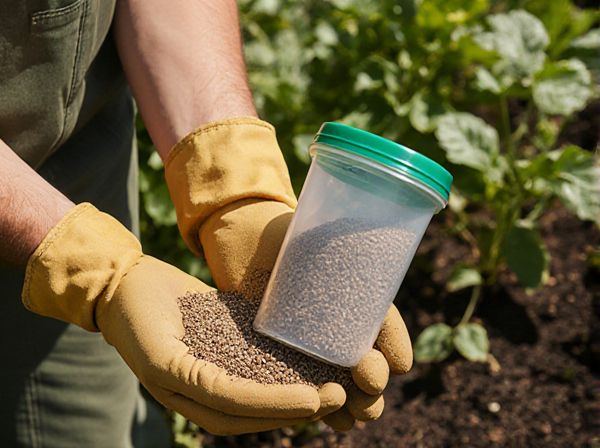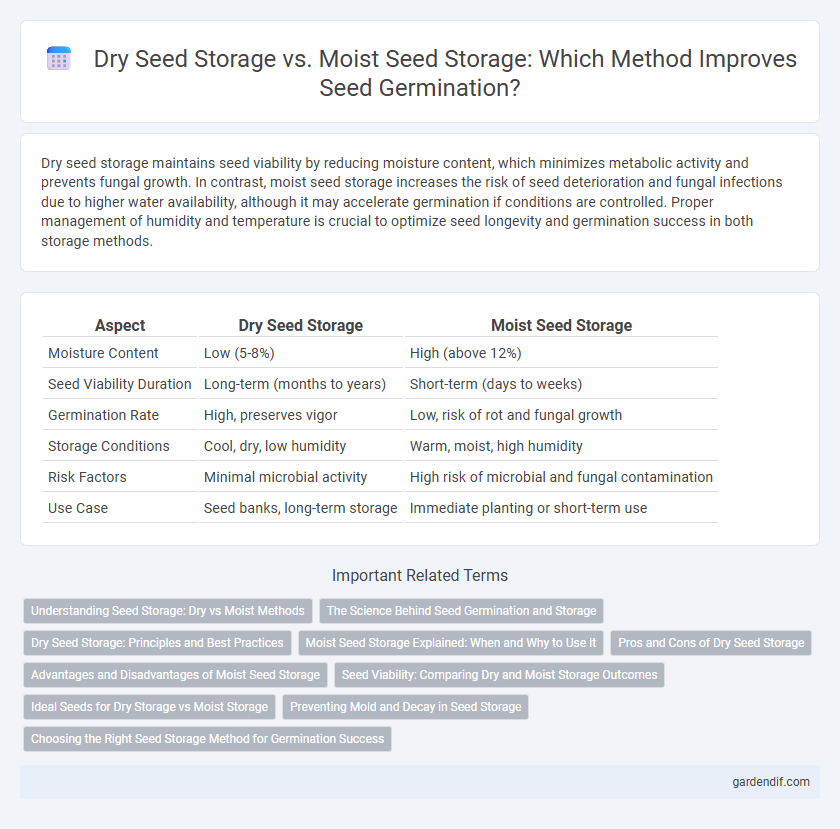
Dry Seed Storage vs Moist Seed Storage Illustration
Dry seed storage maintains seed viability by reducing moisture content, which minimizes metabolic activity and prevents fungal growth. In contrast, moist seed storage increases the risk of seed deterioration and fungal infections due to higher water availability, although it may accelerate germination if conditions are controlled. Proper management of humidity and temperature is crucial to optimize seed longevity and germination success in both storage methods.
Table of Comparison
| Aspect | Dry Seed Storage | Moist Seed Storage |
|---|---|---|
| Moisture Content | Low (5-8%) | High (above 12%) |
| Seed Viability Duration | Long-term (months to years) | Short-term (days to weeks) |
| Germination Rate | High, preserves vigor | Low, risk of rot and fungal growth |
| Storage Conditions | Cool, dry, low humidity | Warm, moist, high humidity |
| Risk Factors | Minimal microbial activity | High risk of microbial and fungal contamination |
| Use Case | Seed banks, long-term storage | Immediate planting or short-term use |
Understanding Seed Storage: Dry vs Moist Methods
Dry seed storage preserves viability by minimizing moisture content, effectively slowing metabolic and enzymatic activities that cause deterioration. Moist seed storage, although increasing germination speed, raises the risk of fungal growth and seed rot due to higher water availability. Optimal seed preservation requires balancing moisture levels to maintain seed vigor while preventing microbial contamination during storage.
The Science Behind Seed Germination and Storage
Dry seed storage maintains seed viability by reducing metabolic activity, thereby slowing deterioration and preserving germination potential over extended periods. Moist seed storage increases water content, which may accelerate metabolic processes but raises the risk of fungal growth and premature germination, compromising seed quality. Understanding the water activity threshold critical for enzyme activation helps optimize germination success during storage.
Dry Seed Storage: Principles and Best Practices
Dry seed storage preserves viability by maintaining low moisture content, typically below 8-10%, which minimizes metabolic activity and fungal growth. Seeds should be stored in airtight containers at controlled temperatures between 4-10degC to extend longevity and germination rates. Best practices include using silica gel desiccants to control humidity and regularly testing moisture levels to prevent deterioration.
Moist Seed Storage Explained: When and Why to Use It
Moist seed storage involves maintaining seeds at a controlled humidity level, typically between 10-14%, to preserve viability and promote faster germination compared to dry storage. This method is particularly useful for short-term preservation of recalcitrant seeds that lose viability quickly when desiccated. Moist storage requires precise moisture and temperature control to prevent fungal growth and seed deterioration while optimizing germination potential.
Pros and Cons of Dry Seed Storage
Dry seed storage preserves seed viability by reducing metabolic activity and preventing fungal growth due to low moisture content, enabling long-term germination potential. However, excessively dry conditions can cause seed coat brittleness and decrease seed vigor, leading to poor germination rates. Maintaining an optimal equilibrium moisture content around 5-8% is crucial to balance longevity and seed integrity during storage.
Advantages and Disadvantages of Moist Seed Storage
Moist seed storage enhances germination rates by maintaining seed viability and promoting metabolic activity necessary for early growth stages. However, it also increases the risk of fungal infections and seed deterioration due to higher moisture content. Proper management and controlled environments are essential to mitigate these disadvantages and maximize germination success.
Seed Viability: Comparing Dry and Moist Storage Outcomes
Dry seed storage maintains higher seed viability over extended periods by minimizing metabolic activity and reducing fungal growth, making it ideal for long-term preservation. Moist seed storage accelerates seed deterioration due to increased respiration rates and microbial proliferation, leading to faster viability loss. Studies reveal that seeds stored under dry conditions exhibit significantly higher germination rates compared to those stored in moist environments.
Ideal Seeds for Dry Storage vs Moist Storage
Ideal seeds for dry storage typically have low moisture content, are orthodox, and can tolerate drying to 5% or below without losing viability, including legumes, cereals, and many vegetable seeds. Moist seed storage favors recalcitrant seeds such as tropical fruit seeds and some hardwood species that require higher moisture levels (above 20%) to maintain metabolic activity and viability. Proper moisture regulation during storage is critical for preserving germination rates and seed vigor according to species-specific tolerance.
Preventing Mold and Decay in Seed Storage
Dry seed storage significantly reduces moisture content, creating an inhospitable environment for mold growth and seed decay, thereby prolonging seed viability. Moist seed storage increases the risk of fungal contamination and rot due to elevated humidity levels that favor microbial activity. Controlling humidity below 8-10% in seed storage is critical for preventing mold proliferation and maintaining seed health.
Choosing the Right Seed Storage Method for Germination Success
Dry seed storage maintains low moisture levels, effectively preventing fungal growth and preserving seed viability for extended periods. Moist seed storage can enhance initial germination rates but increases the risk of mold and premature seed spoilage if not carefully controlled. Selecting the appropriate seed storage method depends on seed type, intended storage duration, and environmental conditions to optimize germination success.
Dry Seed Storage vs Moist Seed Storage Infographic

 gardendif.com
gardendif.com